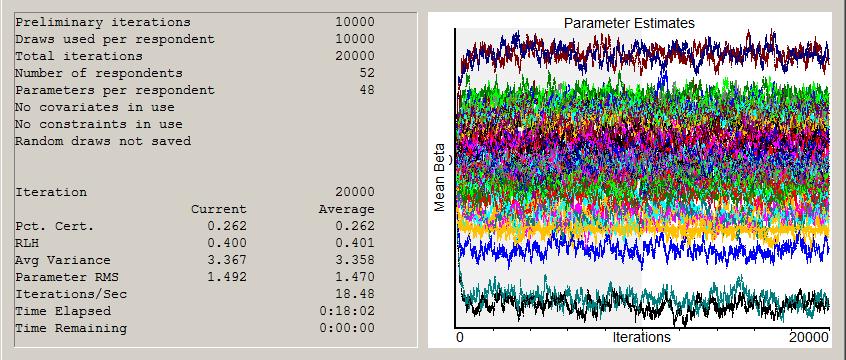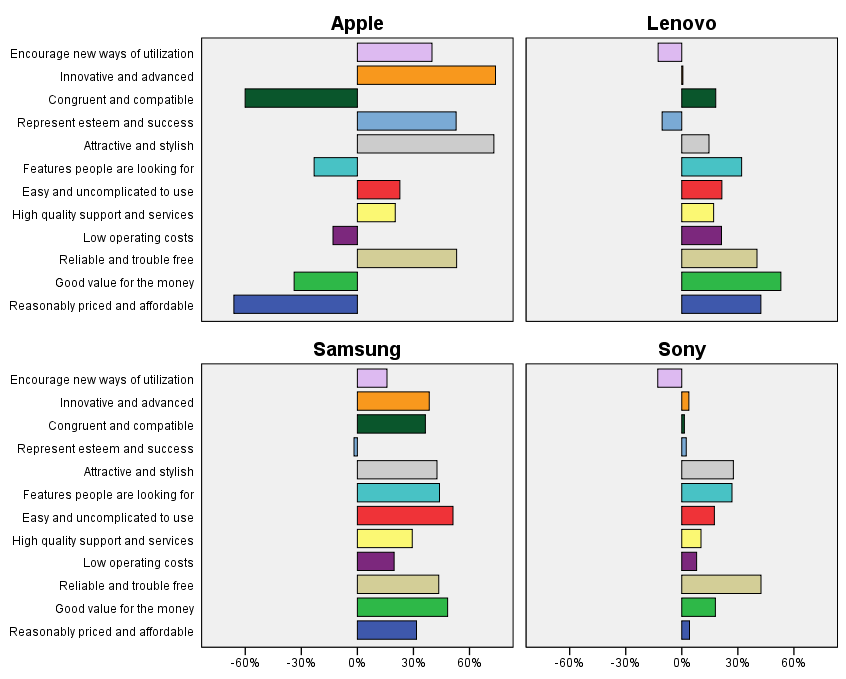 > SCE
- Sequential Choice Exercise > OBIMA - Object Image
Analysis
> SCE
- Sequential Choice Exercise > OBIMA - Object Image
Analysis
Making money and making a difference are mutually supportive goals.
[ Richard Barrett ]
Image evaluation of a collection of objects such as brands (brand image), institutions (employee or customer satisfaction), society (life style) a. o., is an important part of market or public opinion research. Understanding strong and weak points of the objects and differences between them is essential for marketing and/or public communication strategies.
The standard questionnaire is usually built as a sequence of batteries where respondents express their agreement or disagreement with the presented statements, usually on a scale. Results often suffer from low resolution. There are more reasons for that. Even aspects a respondent knows nothing about have to be answered, and many get a more or less random value. With the time spent in useless repetitive activities respondent's annoyance rises and relevant answers are thinning. When an object of respondent's concern finally appears the respondent's attention have been distracted.
Batteries of scale-based questions concerning aspects can be replaced with MXD - Maximum Difference Scaling method. MXD has significantly higher discriminatory power but the interview is substantially longer. Closer inspection in respect to object image estimation will reveal yet other problems.
McCullough (2013) proposed to eliminate the above problems by use of ranking of the tested objects agreement with each of the aspects. The well known Q-Sort method was used for the ranking. Number of MXD choice tasks could be reduced because the loss of information was compensated with information from Q-Sort tasks. The author claims the approach also minimized halo effect of well known objects, namely brands.
 Reference
Reference
McCullough, P. R., 2013. Brand Imagery Measurement: Assessment of Current Practice and a New Approach. Proceedings of the Sawtooth Software Conference, October 2013, p. 147.
The principle of the cited solution lies in linking preferences in the dimension of aspects with preferences in the dimension of objects. The proposed Q-Sort method has a weakness in that a formation of adequate choice tasks for discrete choice modeling is inherently arbitrary. Its usage is possible but the outcome will be dependent on the experience of the questionnaire designer and analyst.
Object image perceptions have two dimensions, objects and aspects. The problem of N objects and M aspects corresponds to elements of the following matrix [bij]:
| Dimension of objects | Dimension of aspects | |||||
| Aspect 1 | Aspect 2 | ... | Aspect M | |||
| Object 1 |
b11 | b12 | ... | b1M | ||
| Object 2 |
b21 | b22 | ... | b2M | ||
| ... |
... | ... | ... | ... | ||
| Object N | bN1 | bN2 | ... | bNM | ||
Estimates of bij as preferences projected on a common scale can be assessed by linking preferences obtained in the two dimensions. In one group of experiments, preferences among M aspects can be obtained independently for each object of the N objects. In the other group, preferences among N objects can be obtained independently for each aspects of the M aspects.
 As aside
As aside
The above matrix can be transposed if it is required by the questionnaire format. This is typical for brands being objects and brand properties being aspects.
The ideal solution would be to use anchored MXD-s in both dimensions. For a medium problem with 8 objects (e.g.. brands) and 16 aspects (characteristics) that would require 8 MXD exercises with 16 aspects and 16 MXD exercises with 8 brands. Such a questionnaire would take unacceptably long time. However, a questionnaire is desirable to be as short as possible, simple to implement, and motivating respondent to reveal object aspects that are important, either appealing and satisfying, or conversely, discouraging or worrisome. Respondents must have chance to skip the items that are irrelevant to them, are uninterested in or know nothing about.
On the page SCE - Sequential Choice Exercise is shown that results from SCE are practically equivalent to those from MXD. For the number of items that can be overlooked on one screen, SCE is much faster than MXD. Furthermore, an importance threshold (anchor) can be represented by one of the items in the SCE exercise and asking additional questions concerning it can be avoided. When the threshold is reached, respondent may terminate the task. This can further reduce the time of questioning. Numerical method for estimating parameters SCE is theoretically justified and, unlike Q-Sort method, unambiguous. In OBIMA method, SCE has been chosen as an appropriate procedure for querying in the both item and aspect dimensions.
The most distinctive property of OBIMA is its ability to capture small differences between objects. The data format and properties allow for seamless segmentation of respondents by latent class, ensemble cluster analysis or other methods.
 For Czech readers
For Czech readers
Krátkou prezentaci v češtině lze stáhnout na odkaze OBIMA_Object-Image-Analysis.pptx
Strengths
Weaknesses
You may experience the look and feel of OBIMA among other live questionnaires.
A test questionnaire was designed as image evaluation of 4 brands (Apple, Lenovo, Samsung and Sony) based on 12 aspects. Image of these brands is well known. Results from the survey were believed to confirm or refute usefulness of the method.
Colleagues from g82, s.r.o., and about 100 office and business
executives from variety of firms were invited to participate. The
questionnaire was opened by 57 and completed by 47 of the invited. Enough
data for processing were obtained from 52 interviews. The average
total interviewing time was about 14 minutes with mode at 11 minutes.
Part-worths of aspects were estimated using program CBC/HB 5.5.3 (Sawtoothsoftware, Inc.). The used behavioral model is very robust as can be seen from the picture of estimation process below. Stabilization was achieved already at 1000 iterations. The quality of the estimates is fully comparable with other studies involving nominal attributes.

There are several ways to present the results. The figure below shows average percentages of "influences" that sum to 100%, as is common in MXD - Maximum Difference Scaling method. The black bar depicts the threshold (anchor) that separates positive from negative perceptions.

 As aside
As aside
It is not very easy to interpret results in the form of the figure above, especially in the region of negative perceptions. The problem is the calculated "influences" themselves. They are always positive and the differences between items with small influences are necessarily also small, although their ratio can be as large as for the items with high positive influences. If the threshold value between positive and negative perceptions is known, one can create a percentage scale roughly equivalent to the commonly used top-box percentages with positive and negative values, as in the figure below.

One can figure out that 74% of respondents considered Apple products as [definitely] innovative and technologically advanced, and, at the same time, 66% as [definitely] expensive and unaffordable.
The results are consistent with the well-known character of the assessed brands as perceived in the Czech Republic. Discriminatory ability between brands and their aspects is also good. Typical are the contradictory perceptions of Apple products affirming their exclusivity. The other three brands are seen generally as positive. Samsung dominates, Sony is characterized by quality that must be payed for, and Lenovo offers value at reasonable price.
Perception threshold is determined independently for each respondent. Calculated percentage values of perception will well (though probably not absolutely) correspond to the actual perceptions in the sample. Segmentation may therefore have good predictive value, also thanks to the fact that the underlying values of perceptions are not squeezed between the lower and upper limits used in scale-based questions (utility values have no restrictions).
The OBIMA design and procedure is based on frequency counts and permits a number of other findings, very similar to those available from website service statistics. E.g. the most challenging statement was "reasonably priced and affordable" that most respondents clicked on. In contrast, respondents were least interested in "high quality support and services", probably because only a few had some experience with it.